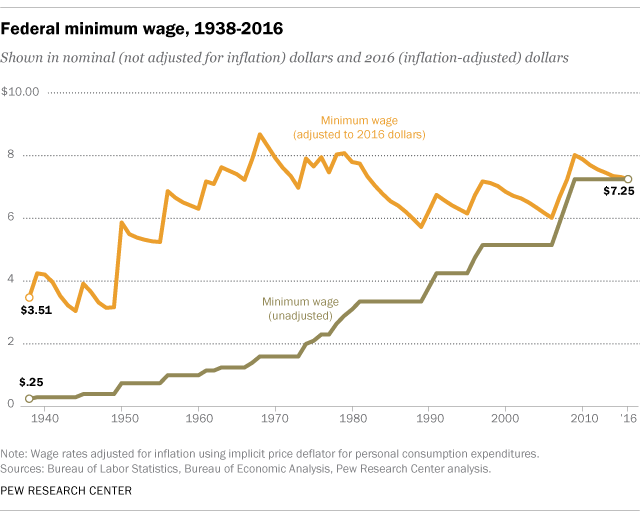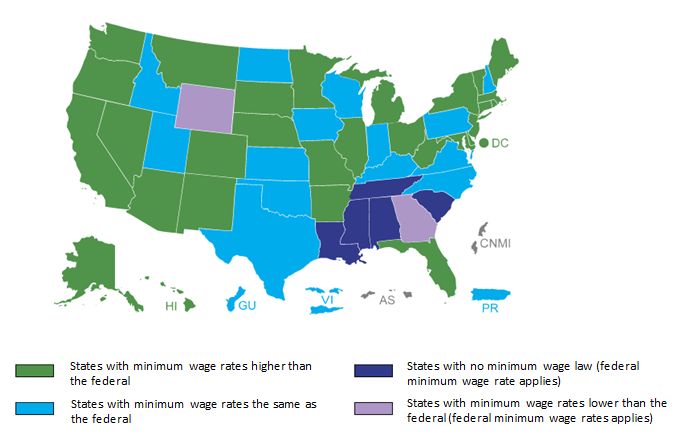The federal minimum wage has remained unchanged at $7.25 per hour since July 2009. However, this minimum may not apply to all 50 states, as states have the leeway to set their own minimum and an employee is entitled to the higher of the two minimum wages.
The minimum wage, the lowest hourly pay that needs to be paid to an employee, is set by the Fair Labor Standard Act.
 Source: Pew Research Center
Source: Pew Research Center
Benzinga looked at how this minimum wage would affect the restaurant sector, which employs the bulk of private-sector workers.
Minimum Wages Going Up
Nineteen (19) states started 2017 with higher minimum wages, according to the National Conference of State Legislatures. These states have increased the minimum, by raising it in line with the cost of living or through ballot initiatives or legislative actions. Washington, D.C., Maryland and Oregon are due to increase their respective minimum wages on July 1.
 Source: Department of Labor
Source: Department of Labor
Currently, there is no indication federal minimum wages will be raised. A survey by Pew Research in August 2016 revealed that 52 percent of those surveyed favored an increase in minimum wages to $15 from the $7.25 currently.
Active Hirer
According to Aspen's Workforce Strategies Initiative report, 1 in 12 private-sector workers in the U.S. were employed in the restaurant industry in 2011. Latest statistics by the National Restaurant Association showed that restaurant workforce comprises 10 percent of the overall workforce, with the total employees employed by the industry at 14.7 million.
Pew Research Center's analysis showed that 3.75 million or about 18 percent of the total employees making near-minimum wages belonged to the restaurant industry, thus making it the single biggest employer of near-minimum-wage workers.
Meanwhile, an infographic based on the Bureau of Labor Statistics data carried by Statista showed about 1.12 million U.S. workers earning minimum or less wages were employed in food preparation and serving.
What A Higher Minimum Wage Means For Restaurant Workers
Restaurant employees who now draw near-minimum wages stand to gain considerably if the federal minimum wages are raised. For the tipped employees of the restaurant industry, if the cash component is increased to the minimum wages, then they stand to benefit from the increased cash component as well as tips that could rise in line with the higher cash component.
On the other hand, this would serve to increase the labor costs of restaurants, which might have no other recourse, but to pass on the hike to consumers. Ultimately, this has the potential of increasing general price levels or the inflation.
Related Links:Whet Your Restaurant Sector Appetite: A 2017 Outlook
Wings Clipped: How Chicken Wings Became Chicken Wing Restaurants' Biggest Headwind
© 2025 Benzinga.com. Benzinga does not provide investment advice. All rights reserved.
Trade confidently with insights and alerts from analyst ratings, free reports and breaking news that affects the stocks you care about.
